I recently got a pair of Bose Ultra Open Earbuds that mark a significant departure from the company’s usual lineup. Bose has long competed with Sony for active noise cancellation (ANC) supremacy, and until now, every headphone or earphone they made featured noise cancellation. However, this new model shifts focus to a different rival—Apple.
With the latest AirPods dominating the open “environment-aware” market, the Bose Ultra Open Earbuds aim to take on Apple. These earbuds wrap around the ear like a cuff, without sealing or even touching the ear canal, allowing listeners to hear both their surroundings and their music simultaneously.
It seems both Bose and Sony have decided it’s time to challenge Apple’s dominance in the open-ear, situational awareness market. With new models from both brands foregoing noise cancellation in favor of transparency and environmental awareness, the battle that once centered on ANC now extends to this growing segment as well.

Build Quality & Fit
Unboxing the Bose Ultra Open Earbuds is a fairly minimal experience, as they include only the case, earbuds, and a USB Type-A to C charging cable. Since this design doesn’t require ear tips, the unboxing feels a bit sparse compared to other in-ears I’ve reviewed. However, Bose makes up for it with an impressive selection of colorways, offering no fewer than nine options.
The classic black and white options are still available, but Bose has expanded the lineup with colors like carbon blue, sunset iridescent, chilled lilac, lunar blue, sandstone, moonstone blue, and a special Anniversary Diamond 60th Edition in white and silver. The pair I received for review is the black colorway, with the case and rubber portions of the earpieces matching.
The earpieces feature an L-shaped bar made of hard polymer with a metal outer panel that sits near the ear. Attached to the long arm of the L is a soft rubber section that connects the bar to a barrel-shaped component resting behind the ear.
The barrel is also made of polymer, featuring a button on the top surface and three contact points on the bottom. This design is clever, as the soft section is spring-loaded, ensuring a secure fit regardless of ear shape or size while remaining comfortable—something that some other designs struggle with.
At 6.4 grams, the Bose Ultra Open Earbuds are a full gram heavier than the AirPods Pro (2nd Gen). However, the weight is evenly distributed between the front and rear portions of the cuff, preventing any feeling of imbalance or pull in one direction.
The earbuds have an IPX4 rating, making them suitable for workouts and light splashes, but they are not waterproof and shouldn’t be used in the pool. The case, however, lacks an IP rating and should be kept away from moisture.
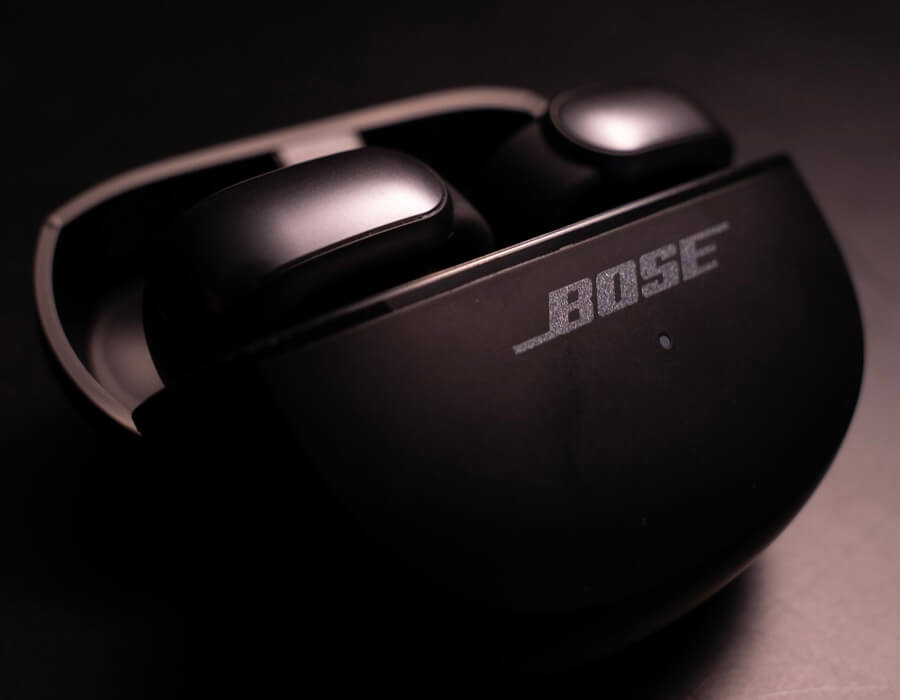
The case design follows the familiar Bose aesthetic, featuring a rounded clamshell shape with a USB-C charging port on the bottom and a pairing button on the back, similar to other Bose models.
One thing I’ve noticed with Bose cases, and which is even more pronounced on the Ultra Open, is that the top portion twists on the hinge quite a bit. While it shouldn’t be an issue with gentle handling, I can see rough use potentially leading to the top snapping at the hinge.
The case has a single LED indicator on the front, just below the Bose logo. Inside, there are two additional LED indicators that show the charge status of the earbuds when they’re connected; the case is a bit smaller than the QuietComfort II and QuietComfort Ultra models as the earbuds sit in the top rather than reaching down into the case.
Controls & App
When the case is first opened, the earbuds attempt to pair automatically. If they’ve been previously paired, the button on the back of the case can be used to manually enter pairing mode. Initially, early pairs lacked multipoint support, but a firmware update in mid-2024 added this feature, and newer pairs now ship with it enabled by default.
The Bose app, available for both Android and iPhone, offers a simple music player along with mode controls (stereo and immersive modes). It includes a three-band EQ with four presets, as well as the option to manually adjust each level. Additionally, the app allows you to customize shortcut functions for more control.
The buttons on the earpieces provide three fixed functions: a single press of either button controls play/pause, a double press skips to the next track, and a triple press goes to the previous track. Volume control is done by a double press and hold: the right bud raises the volume, while the left lowers it.
Shortcuts are accessed by pressing and holding the buttons, and these can be customized through the app. Either button can be set to cycle through available modes (Stereo and Immersive), adjust the type of immersion (Off, Still, or Motion), switch between connected devices, or activate the voice assistant.
It’s important to note that multipoint Bluetooth must be enabled in the app (if not already activated), and multiple devices need to be paired before the “switch devices” function will work. The app also allows you to manage devices, add new ones, and forget devices no longer in use.
Features
The Bose Ultra Open Earbuds offer Bluetooth 5.3 with AAC, SBC, Snapdragon Sound, and AptX Adaptive connectivity support; this combination of protocols ensures broad device compatibility, supporting iOS, Android, Windows, and macOS devices.
While very few devices currently support Snapdragon Sound, it provides future-proofing, as upcoming devices like Samsung’s Galaxy S25 and OnePlus’s 13 are expected to support it in the near future.
While situational awareness is the primary focus of the Bose Open Earbuds, they still retain features from other Bose models, including support for both immersive audio and head tracking. Immersive Audio is Bose’s spatialization feature that creates a more 3D sound field.
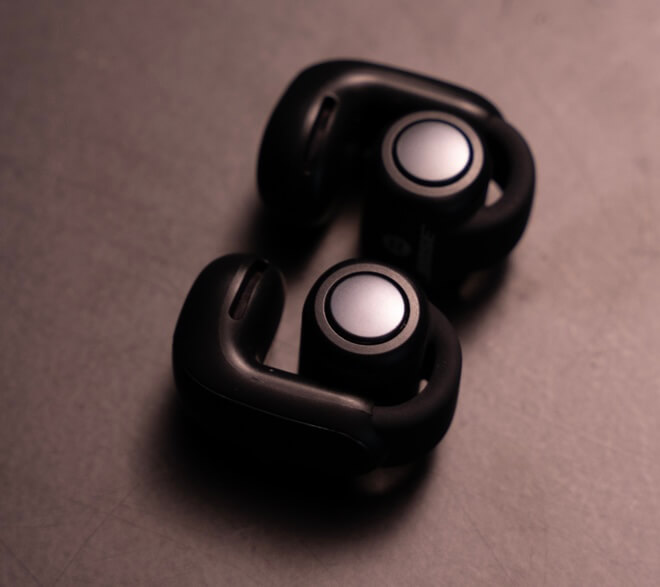
When paired with the two head tracking modes, it can either provide a fixed perspective with the listener at the center or adjust the perspective as the user moves their head.
For me, the use of Immersive Audio is a mixed blessing. Some tracks respond well to this treatment, creating a more engaging experience, while others can sound quite artificial when processed. Additionally, enabling Immersive Audio and head tracking significantly impacts battery life (more on this in the battery section), so it’s something to consider when deciding whether to activate spatialization.
As mentioned earlier, the Bose Ultra Open Earbuds feature a fairly basic 3-channel equalizer, along with four preset options to adjust the tonality. Interestingly, one of these presets is a bass reduction setting, which seems like a carryover from other models, as open designs typically don’t suffer from excess bass.
The voice-calling features of the Bose Open Earbuds are similar to those found in other Bose offerings and appear to be directly lifted from the QuietComfort Ultra Earbuds, as both the controls and performance are identical.
The result is good noise reduction during calls, though some background noises can still be heard. Overall, call performance is quite good. One downside, however, is that the buds are not conversation-aware like some offerings from Sony or Apple, meaning your music won’t automatically pause when a call comes in.
Another miss is the lack of an on-ear sensor, meaning removing the earbuds doesn’t automatically stop the music, leading to continued battery drain. To stop the music without handling the source device, the earbuds must be placed back in their case, which also breaks the connection to the source.
Earbuds as Surround Speakers
For those with home theater aspirations, Bose Ultra Open Earbuds have one feature no other earbud maker offers — soundbar integration. When used with the Bose Smart Soundbar ($499), the Bose Ultra Open Earbuds can function as surround speakers in a home theater setup. Due to their open nature, the earbuds let you hear both the soundbar and rear/side spatial audio effects at the same time. Check out the video with Ealan Osborne to see how it works.
Battery Performance
One big plus for the Bose Ultra Open Earbuds is their impressive battery life. Advertised at 7 hours at moderate volume, they provide enough battery to last through a workday with some careful volume management. Additionally, the case offers two full charges and a partial third charge, allowing the earbuds to last nearly a full work week without needing to recharge the case.
One downside is that the app shows the charge state of the earbuds but not the case, leaving the single LED on the front panel as the only indicator of the case’s charge. It would be better to have a more granular system, as the current “charged, charging, and dead” indicator feels a bit too abrupt.
I also would have liked to see the case natively support wireless charging, rather than requiring an additional purchase of a wireless charging case cover.
Listening
I’ll start by saying open designs will not please those looking for big bass. If you’re after a lot of well-textured lows, it’s best to skip the open options altogether. Bass requires large volumes of air to impact the eardrum, which is nearly impossible to achieve in an open environment.
In home audio, even small rooms typically require a dedicated subwoofer to produce deep bass. With open earbuds, which essentially operate in that same room-sized space, it’s simply not possible to include a large enough transducer or one with enough excursion to move the necessary air.
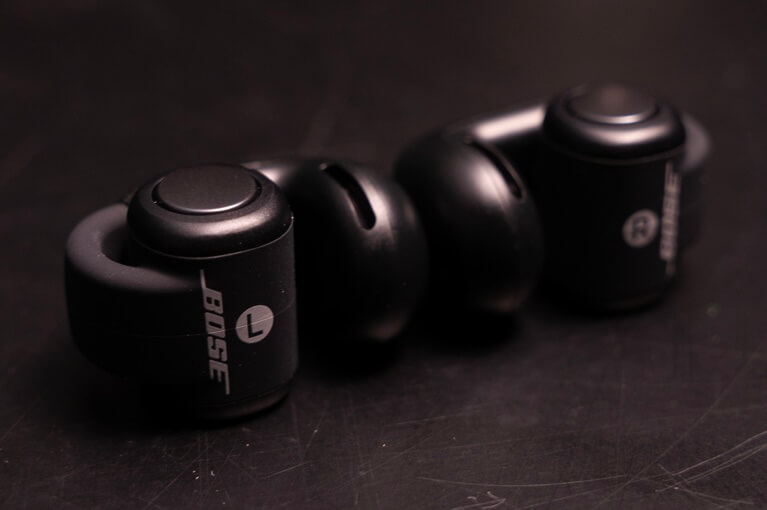
Bose uses a 12mm dynamic driver in the Open Earbuds (compared to the 9.4mm of the QC Ultra) to help deliver more lows, but it’s important to temper your expectations when it comes to bass performance.
At the low end, the Bose Open Earbuds deliver solid mid-bass but start to lose impact below about 120Hz, which is typical for an open-back design. What’s present is clean and well-defined, though kick drums can occasionally sound a bit hollow. The positive side is that there’s still enough low-end presence to let bass guitar establish the rhythm and anchor the track, which is really all that’s needed for an earbud design like this.
The mids are definitely the highlight of the Bose Ultra Open Earbuds. Guitars have a nice growl, and vocals cut through the mix effectively. There’s also good note weight, which helps prevent voices from sounding hollow or thin, a common issue with open designs.
In classical music, the cello has nice depth, and violins maintain their energy without becoming harsh. This range also benefits voice calls, as voices are well-defined and clear, making for a solid experience whether listening to music or talking on the phone.
The upper end of the Bose Ultra Open Earbuds certainly delivers that signature airiness and openness typical of open designs. They offer solid top-end extension with a good amount of detail, which makes percussion sound snappy and lively. This helps compensate for the slight loss of bass by keeping the overall sound balanced and well-defined, especially in the higher frequencies. It’s a nice touch that enhances the clarity and crispness of instruments like cymbals and hi-hats.
That’s definitely a pleasant surprise with the Bose Ultra Open Earbuds. Open designs are usually notorious for letting sound leak out, making it a potential issue for those around you. However, the way these earbuds are constructed seems to minimize that, which is a big plus if you’re using them in public spaces or around others. It seems like Bose has found a good balance between maintaining situational awareness for the wearer while keeping their music more private.
That’s a solid advantage, especially in shared spaces like offices or public transportation. Your boss may never notice that you’re rocking out to Metallica while preparing his TPS Report.
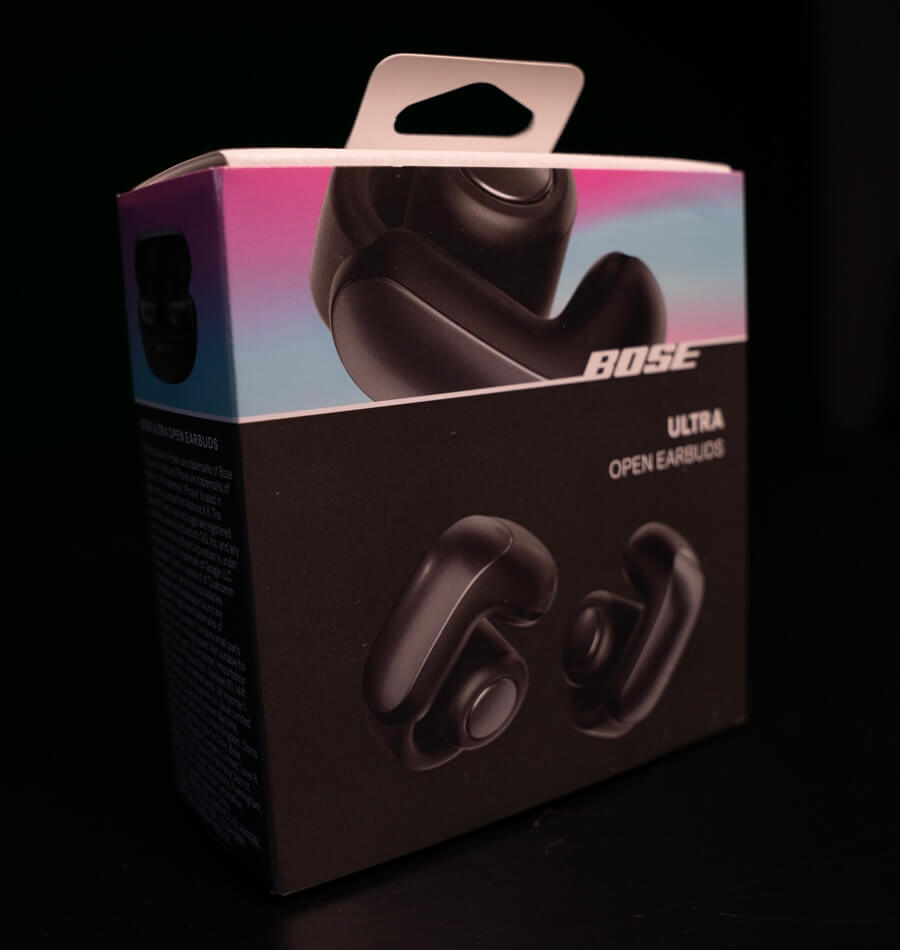
The Bottom Line
Bose has long been a leader in noise cancellation, but with growing demand for situational awareness, the company has shifted focus to cater to consumers who want to balance audio immersion with the ability to hear their surroundings. This has led to the introduction of open and semi-open earbud designs, which allow environmental sounds in for safety and awareness.
The Bose Ultra Open Earbuds feature a unique design with a variety of color options to appeal to fashion-conscious buyers. With impressive battery life that can last nearly a week for office users, they provide a great balance of situational awareness and audio performance. These earbuds cater to those who value both style and good battery performance.
While the $299 price tag places the Bose Ultra Open Earbuds in the premium market, additional features like ear-sensors and a wireless charging case should have been standard features. However, for many buyers, the unique design, long battery life, and situational awareness features they offer will be compelling enough to justify the price.
Pros
- Innovative cuff-like design
- Good all day comfort and battery life
- Solid sound performance (with limits of design)
- Good situational awareness without lots of leakage
- Optional use as surround speakers
Cons
- Best used in quiet environments
- No wireless charging
- No on-ear sensors

Where to buy
Related Reading






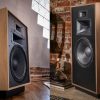





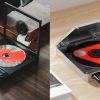
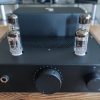


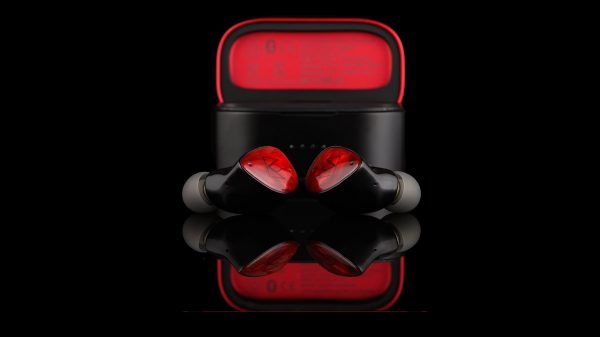

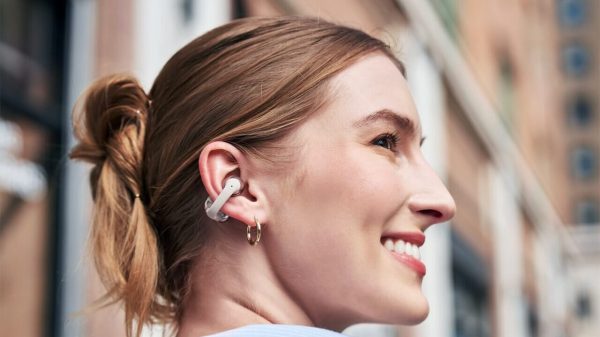

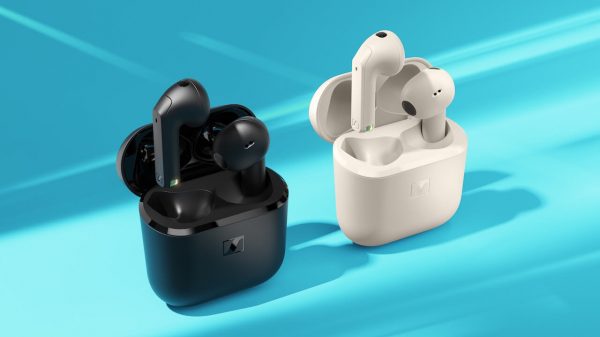


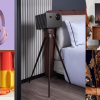
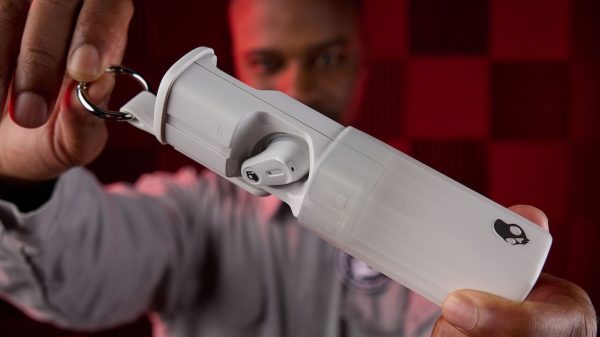



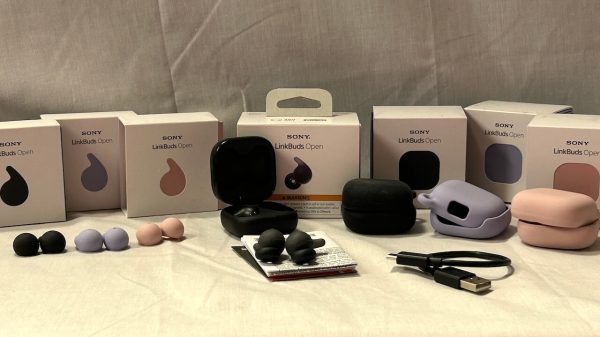
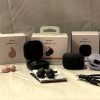











Antonio Montoya
April 4, 2025 at 12:56 pm
Fantastic review. Well written as well. Have never been a Bose fan but these seem like a decent option.
I just don’t get the earbuds thing. Have never found a pair that fit correctly and you always manage to lose one.
Perhaps they should build a locator inside them for the price.
Ian White
April 4, 2025 at 6:00 pm
Bose is making really decent headphones and IEMs and while everyone rolled their eyes at the McIntosh Group acquisition, those billions from the sale of the headphones, IEMs, and car audio systems paid for that acquisition.
How many high-end audio companies have billions in sales revenue? ZERO.
IW
Sunburstbfz
April 4, 2025 at 2:29 pm
Duke de Montosier
Debra
April 6, 2025 at 1:00 am
These have changed my life. My ears ache after 30 minutes of in ear buds and none of t he outside options have ever worked. Big fan!
Ian White
April 6, 2025 at 2:55 pm
Debra,
Good to read that. The open-ear format is becoming a lot more popular. And for good reason.
IW
Paul
April 15, 2025 at 2:24 am
Just got these had the older Bose open ear. These are complete trash, you can barely hear the music at 100% volume. I’m returning these. Very disappointed
Grayson
June 1, 2025 at 1:10 am
You Must’ve not had them on right, I got mine a few days ago and can hear it clearly on a lower volume. Took me a few gets to find the sweet spot tho
Trevor Chadwick
May 21, 2025 at 4:13 pm
Returned these. Need to be much louder. They’re about 1/2 as loud as the $30 Tozo earrings.